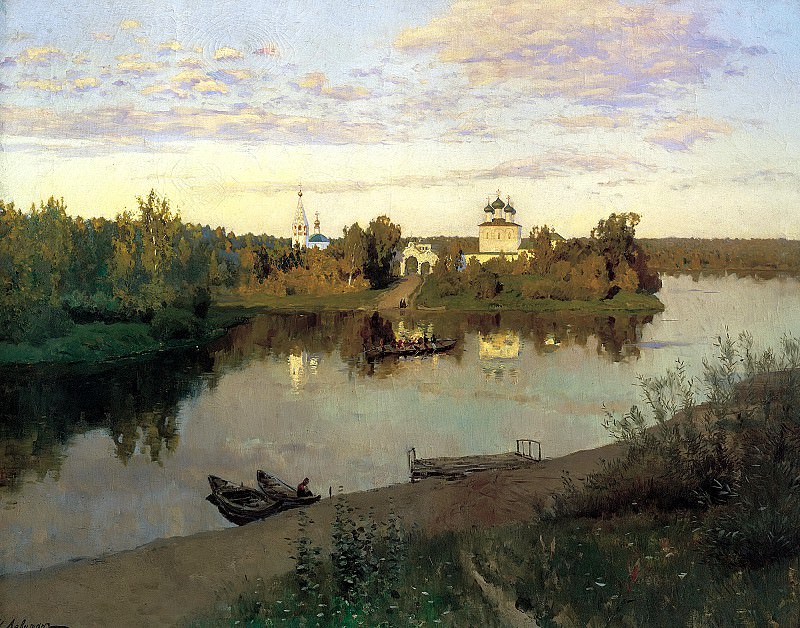Isaak Levitan – Evening Bell 900 Classic russian paintings
Isaak Levitan - Evening Bell
Edit attribution
Download full size: 2000×1568 px (1,6 Mb)
Back to album: 900 Classic russian paintings
Isaac Levitan, a great master of the brush and a man with a difficult fate, left a great legacy represented by vivid and expressive landscapes. In 1892 the artist created the painting "Evening Chime". This picture reflected impressions that the author received on a trip to holy places on the Volga. The monasteries he saw became the basis of an unusually poetic image, which is in tune with the famous music and poems, the church bell ringing. The master depicts a sultry summer evening.
Description of Isaac Levitan’s painting "Evening Ringing
Isaac Levitan, a great master of the brush and a man with a difficult fate, left a great legacy represented by vivid and expressive landscapes.
In 1892 the artist created the painting "Evening Chime". This picture reflected impressions that the author received on a trip to holy places on the Volga. The monasteries he saw became the basis of an unusually poetic image, which is in tune with the famous music and poems, the church bell ringing.
The master depicts a sultry summer evening. In the rays of the blazing sunset one can hear the bell ringing, inviting to evening prayer. Another, coming to the end of the day brings a pleasant longing and sadness and anticipation of a new day.
The natural solemnity and grandeur is emphasized by the slightly darkening sky with a wide pinkish haze over it. The heavenly height is reflected in the smooth and serene water surface in gray streaks.
The river flows wide and calmly between the dark shores, sandy at the water’s edge, and further covered with bushes. On the smooth water in a boat cross over to the other side of the river people are pilgrims. They are in a hurry to be in time for the evening service. On the other side of the river the helpful monks are already waiting for them. And two boats with a bored boatman, wooden gangway remains on this shore.
In the clear and quiet water are also reflected in the white stone walls and golden domes of monasteries, a sharp spire of the bell tower. The majestic buildings themselves are hidden behind the greenery of trees. Spiritual and natural principles that lead to silence and tranquility are as if merged here.
"Evening Chime" is one of the significant paintings of the great landscape artist. It shows the skill of an experienced painter who can see the beauty of nature and embody it on the canvas in colors. Here you can clearly see the mood of the author, his desire for the divine. Extraordinarily majestic and mesmerizing soul music of the artist is transmitted to the viewer.
Кому понравилось
Пожалуйста, подождите
На эту операцию может потребоваться несколько секунд.
Информация появится в новом окне,
если открытие новых окон не запрещено в настройках вашего браузера.
You need to login
Для работы с коллекциями – пожалуйста, войдите в аккаунт (open in new window).




















COMMENTS: 2 Ответы
Вечерний звон – Бом, Бом...
Очень красивая картина передает в действительности какая раньше была Русь добрая тихая
You cannot comment Why?
In Isaak Levitans painting Evening Bell (also known as Evening Bells or Golden Evening), we are presented with a serene and picturesque view of a wide river reflecting the soft hues of the setting sun. The scene is dominated by a tranquil body of water that occupies the majority of the canvas, its surface shimmering with the colors of the sky.
On the far bank, nestled among lush green trees, stands a prominent monastery complex, characterized by its whitewashed walls and onion-domed churches, one with a tall, slender bell tower. An archway leads to the monastery grounds, and a few small figures can be seen walking along a path. The monasterys reflection is clearly visible in the calm river, creating a sense of symmetry and adding to the paintings peaceful atmosphere.
Closer to the viewer, on the riverbank, two small wooden boats are moored. In one of them, a lone figure is seated, adding a touch of human presence to the landscape. A small wooden pier extends into the water from the bank in the foreground, further enhancing the sense of a quiet, lived-in, yet wild setting. The vegetation along the riverbanks is rich and varied, with trees lining the distant horizon and grass and bushes in the foreground.
The sky above is filled with soft, diffused clouds painted in shades of pale gold, pink, and lavender, indicating the approach of twilight. The overall impression is one of profound peace, stillness, and a deep connection to nature and spirituality.
The paintings subtexts evoke a sense of nostalgia and contemplation. The evening bell in the title itself suggests a winding down of the day, a time for reflection and perhaps prayer. The presence of the monastery points to spirituality and the enduring nature of faith against the backdrop of a changing world. The vastness of the river and the gentle light can symbolize the passage of time, the flow of life, and a quiet acceptance of its rhythm.
Levitan, known for his mastery of mood landscapes, imbues this scene with a profound emotional resonance. It speaks to the beauty of the Russian landscape, the quiet grandeur of its religious architecture, and the introspective mood that often accompanies the end of a day. The painting invites the viewer to pause, breathe, and connect with a sense of timeless tranquility and spiritual peace.